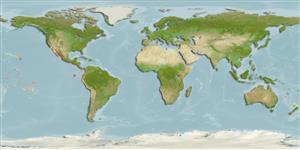Common names from other countries
Environment: milieu / climate zone / depth range / distribution range
Ecologia
marinhas associadas(os) a recifes; intervalo de profundidade 5 - 25 m (Ref. 9324). Tropical
Eastern Pacific: Gulf of California to Islas Lobos de Afuera, Peru, including the Galapagos Islands.
Tamanho / Peso / Idade
Maturity: Lm ? range ? - ? cm
Max length : 61.0 cm TL macho/indeterminado; (Ref. 5590); common length : 35.0 cm TL macho/indeterminado; (Ref. 57763)
Descrição suscinta
Morfologia | Morfometria
Head and jaws very much compressed; body tapering posteriorly. Body depth at the middle about 1/13 of the entire length; the head about 1/7, measured to the branchial orifice. Jaws very narrow, sharp-pointed and equal. Gape deeply cleft. Teeth compressed at the sides, very sharp, slightly hooked and pointing backwards. Two tubular orifices above the eyes and two at the extremity of the snout. Distance of eyes from the end of the snout about twice the eye diameter. Branchial orifice and eyes of same size. Dorsal fin thick and fleshy. Color is fine dark purplish brown, with yellow circular spots; the spots mostly small. (Ref. 3157).
Often seen in shallow water. Remains under cover in rocky crevices during the day. Feeds mainly at night on crustaceans and fishes (Ref. 6852). Constantly opens and closes it mouth, an action required for respiration, not a threat (Ref. 5227).
Ciclo de vida ou comportamento de acasalamento
Maturidade | Reprodução | Desova | Ovos | Fecundidade | Larvas
Merlen, G., 1988. A field guide to the fishes of Galapagos. Wilmot Books, London, England 60 p. (Ref. 5590)
Status na Lista Vermelha da UICN (Ref. 130435)
CITES (Ref. 128078)
Not Evaluated
Ameaça para os humanos
Harmless
Uso pelos humanos
Mais informação
Nomes comunsSinônimosMetabolismoPredadoresEcotoxicologiaReproduçãoMaturidadeDesovaFecundidadeOvosDesenvolvimento dos ovos
Idade/TamanhoCrescimentoPeso-comprimentoComprimento-comprimentoFrequências de comprimentoMorfometriaMorfologiaLarvasDinâmica larvalRecrutamentoAbundância
ReferênciasAquaculturaPerfil para aquaculturaEstirpesGenéticaElectrophoresesHereditariedadeDoençasProcessamentoConversão de massa
Ferramentas
Relatórios especiais
Baixar XML
Fontes da internet
Estimates based on models
Preferred temperature (Ref.
115969): 22.3 - 29.1, mean 26.7 (based on 244 cells).
Índice de diversidade filogenética (Ref.
82804): PD
50 = 0.5010 [Uniqueness, from 0.5 = low to 2.0 = high].
Bayesian length-weight: a=0.00050 (0.00025 - 0.00101), b=3.26 (3.10 - 3.42), in cm Total Length, based on LWR estimates for this (Sub)family-body shape (Ref.
93245).
Nível Trófico (Ref.
69278): 3.9 ±0.61 se; based on food items.
Resiliência (Ref.
120179): médio(a), tempo mínimo de duplicação da população 1,4 - 4,4 anos (Preliminary K or Fecundity.).
Fishing Vulnerability (Ref.
59153): Moderate vulnerability (44 of 100).
